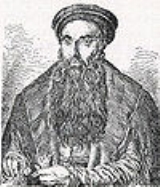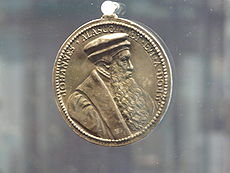
Jan Laski
Encyclopedia

Poland
Poland , officially the Republic of Poland , is a country in Central Europe bordered by Germany to the west; the Czech Republic and Slovakia to the south; Ukraine, Belarus and Lithuania to the east; and the Baltic Sea and Kaliningrad Oblast, a Russian exclave, to the north...
Protestant evangelical
Evangelicalism
Evangelicalism is a Protestant Christian movement which began in Great Britain in the 1730s and gained popularity in the United States during the series of Great Awakenings of the 18th and 19th century.Its key commitments are:...
reformer. It is owing to his influential work in England (ca. 1543-1555), during the English Reformation
English Reformation
The English Reformation was the series of events in 16th-century England by which the Church of England broke away from the authority of the Pope and the Roman Catholic Church....
, that his name is known to the English-speaking world in its Anglicised form John a Lasco.
Life

Bakowa Góra
Bąkowa Góra is a village in the administrative district of Gmina Ręczno, within Piotrków County, Łódź Voivodeship, in central Poland. It lies approximately south of Ręczno, south-east of Piotrków Trybunalski, and south of the regional capital Łódź....
. His uncle, also Jan Łaski, was by turns royal secretary, Archbishop of Gniezno, Primate of Poland and Grand Chancellor of the Crown; he was also the uncle of King Sigismund I the Old
Sigismund I the Old
Sigismund I of Poland , of the Jagiellon dynasty, reigned as King of Poland and also as the Grand Duke of Lithuania from 1506 until 1548...
. Both Jan Łaskis' coat-of-arms was Korab.
After his family's fall from political power and prestige, Łaski, a learned priest, went in 1523 to Basel
Basel
Basel or Basle In the national languages of Switzerland the city is also known as Bâle , Basilea and Basilea is Switzerland's third most populous city with about 166,000 inhabitants. Located where the Swiss, French and German borders meet, Basel also has suburbs in France and Germany...
, where he became a close friend of Erasmus and Zwingli. In 1542 he became pastor of a Protestant church at Emden
Emden
Emden is a city and seaport in the northwest of Germany, on the river Ems. It is the main city of the region of East Frisia; in 2006, the city had a total population of 51,692.-History:...
and shortly after went to England
England
England is a country that is part of the United Kingdom. It shares land borders with Scotland to the north and Wales to the west; the Irish Sea is to the north west, the Celtic Sea to the south west, with the North Sea to the east and the English Channel to the south separating it from continental...
, where in 1550 he was superintendent of the Strangers' Church of London
Stranger churches
Strangers' church was a term used by English-speaking people for independent Protestant churches established in foreign lands or by foreigners in England during the Reformation...
and had some influence on ecclesiastical affairs in the reign of Edward VI
Edward VI of England
Edward VI was the King of England and Ireland from 28 January 1547 until his death. He was crowned on 20 February at the age of nine. The son of Henry VIII and Jane Seymour, Edward was the third monarch of the Tudor dynasty and England's first monarch who was raised as a Protestant...
.
In 1551 he excommunicated, and had burned at the stake for Arianism
Arianism
Arianism is the theological teaching attributed to Arius , a Christian presbyter from Alexandria, Egypt, concerning the relationship of the entities of the Trinity and the precise nature of the Son of God as being a subordinate entity to God the Father...
, a member of his London congregation, George van Parris
George van Parris
George van Parris was a Dutch Arian, who was burnt at the stake in London by his fellow Protestants.George van Parris was a member of the Stranger's Church congregation, and his excommunication and subsequent burning were done with the agreement of the pastor of the congregation, John Lasco...
,
Under Mary I's
Mary I of England
Mary I was queen regnant of England and Ireland from July 1553 until her death.She was the only surviving child born of the ill-fated marriage of Henry VIII and his first wife Catherine of Aragon. Her younger half-brother, Edward VI, succeeded Henry in 1547...
persecution, Łaski took a shipload of refugees from the Strangers' Church to Copenhagen
Copenhagen
Copenhagen is the capital and largest city of Denmark, with an urban population of 1,199,224 and a metropolitan population of 1,930,260 . With the completion of the transnational Øresund Bridge in 2000, Copenhagen has become the centre of the increasingly integrating Øresund Region...
, but they were denied refuge there because they would not accept the Augsburg Confession
Augsburg Confession
The Augsburg Confession, also known as the "Augustana" from its Latin name, Confessio Augustana, is the primary confession of faith of the Lutheran Church and one of the most important documents of the Lutheran reformation...
of Faith. They were resettled in Brandenburg
Brandenburg
Brandenburg is one of the sixteen federal-states of Germany. It lies in the east of the country and is one of the new federal states that were re-created in 1990 upon the reunification of the former West Germany and East Germany. The capital is Potsdam...
.
Łaski was a correspondent of John Hooper
John Hooper
John Hooper, Johan Hoper, was an English churchman, Anglican Bishop of Gloucester and Worcester. A Protestant Reformer, he was killed during the Marian Persecutions.-Biography:...
, whom Łaski supported in the vestments controversy
Vestments controversy
The vestments controversy arose in the English Reformation, ostensibly concerning vestments, but more fundamentally concerned with English Protestant identity, doctrine, and various church practices...
.
On the accession of Roman Catholic Queen Mary
Mary I of England
Mary I was queen regnant of England and Ireland from July 1553 until her death.She was the only surviving child born of the ill-fated marriage of Henry VIII and his first wife Catherine of Aragon. Her younger half-brother, Edward VI, succeeded Henry in 1547...
, he fled to the continent. In 1556 he was recalled to Poland
Poland
Poland , officially the Republic of Poland , is a country in Central Europe bordered by Germany to the west; the Czech Republic and Slovakia to the south; Ukraine, Belarus and Lithuania to the east; and the Baltic Sea and Kaliningrad Oblast, a Russian exclave, to the north...
, where he became secretary to King Sigismund II and was a leader in the Calvinist Reformation
Calvinism
Calvinism is a Protestant theological system and an approach to the Christian life...
.
His contributions to the Reformed churches were the establishment of church government in theory and practice, a denial of any distinction between ministers and elders except in terms of who could teach and administer the sacraments, and an understanding of the eucharist
Eucharist
The Eucharist , also called Holy Communion, the Sacrament of the Altar, the Blessed Sacrament, the Lord's Supper, and other names, is a Christian sacrament or ordinance...
that was more Zwinglian than Calvinist. Łaski tried to reorient the debate by focusing on the entire ceremony, participation in which "seals" Christians in communion with Christ.
He died in Pinczów
Pinczów
Pińczów is a town in Poland, in Świętokrzyskie Voivodship, about 40 km south of Kielce. It is the capital of Pińczów County. Population is 12,304 .-History:...
, Poland
Poland
Poland , officially the Republic of Poland , is a country in Central Europe bordered by Germany to the west; the Czech Republic and Slovakia to the south; Ukraine, Belarus and Lithuania to the east; and the Baltic Sea and Kaliningrad Oblast, a Russian exclave, to the north...
.
He is one of the figures on the Prussian Homage
Prussian Homage (painting)
The Prussian Homage is an oil on canvas painting by Polish painter Jan Matejko painted between 1879 and 1882 in Kraków, then part of Austria-Hungary. It depicts a tribute made by Albrecht Hohenzollern, the Duke of Prussia, to King Sigismund I the Old in the Kraków market square on 10 April 1525;...
painting by Jan Matejko
Jan Matejko
Jan Matejko was a Polish painter known for paintings of notable historical Polish political and military events. His most famous works include oil on canvas paintings like Battle of Grunwald, paintings of numerous other battles and court scenes, and a gallery of Polish kings...
.
Works
- Forma ac ratio (1555) -- A "Form and Rationale" for the liturgy of the Stranger churchesStranger churchesStrangers' church was a term used by English-speaking people for independent Protestant churches established in foreign lands or by foreigners in England during the Reformation...
in London. Possibly influenced the 1552 Book of Common PrayerBook of Common PrayerThe Book of Common Prayer is the short title of a number of related prayer books used in the Anglican Communion, as well as by the Continuing Anglican, "Anglican realignment" and other Anglican churches. The original book, published in 1549 , in the reign of Edward VI, was a product of the English...
, John KnoxJohn KnoxJohn Knox was a Scottish clergyman and a leader of the Protestant Reformation who brought reformation to the church in Scotland. He was educated at the University of St Andrews or possibly the University of Glasgow and was ordained to the Catholic priesthood in 1536...
's Scottish order, the Middleburg ordinal, the 1563 German Palatinate order, and the "forms and prayers" in Pieter Dathenus' psalter, which was influential in Dutch Calvinist churches. - Johannes a Lasco, Opera (Works), ed. Abraham KuyperAbraham KuyperAbraham Kuijper generally known as Abraham Kuyper, was a Dutch politician, journalist, statesman and theologian...
(Amsterdam: F. Muller, 1866).
See also
- Jan Łaski (1456–1531)
- Andrzej Frycz ModrzewskiAndrzej Frycz ModrzewskiAndrzej Frycz Modrzewski was a Polish Renaissance scholar, humanist and theologian, called "the father of Polish democracy." His book De Republica emendanda was widely read and praised across most of Renaissance Europe.-Life:Modrzewski was born in Wolbórz Andrzej Frycz Modrzewski (ca....
- Wacław of Szamotuły
- List of Poles

